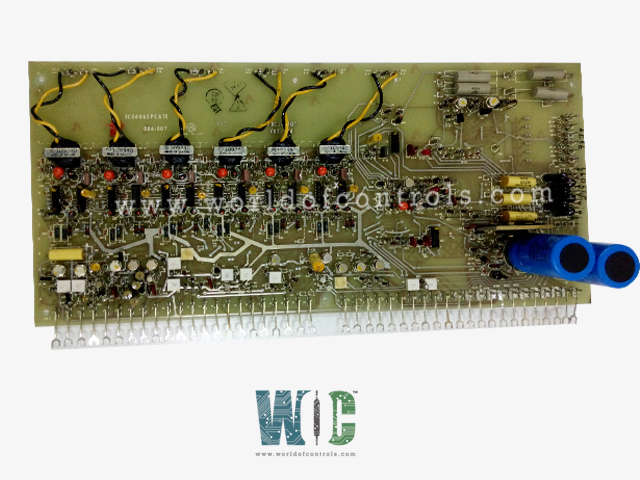
World Of Controls understands the criticality of your requirement and works towards reducing the lead time as much as possible.
IC3606SPCA1E - Simplex Thermocouple Processor Module is available in stock which ships the same day.
IC3606SPCA1E - Simplex Thermocouple Processor Module comes in UNUSED as well as REBUILT condition.
To avail our best deals for IC3606SPCA1E - Simplex Thermocouple Processor Module, contact us and we will get back to you within 24 hours.
SPECIFICATIONS:
Part No: IC3606SPCA1E
Manufacturer: General Electric
Product Type: Simplex Thermocouple Processor Module
Series: Mark I & II
Input Voltage: 100-240V AC, 50/60Hz
Output Current: 0.15 A AMP
Output Voltage Range: 0-50V DC
Operating Temperature: 0°C to 40°C
Resolution: 10mV/10mA
Availability: In Stock
Weight: 2.5 kg
Dimensions: 6.00 x 6.00 x 5.00
Country of Origin: USA
FUNCTIONAL DESCRIPTION:
IC3606SPCA1E is a Simplex Thermocouple Processor Module manufactured and designed by General Electric and is part of the Mark II Series used in the GE Speedtronic Gas Turbine Control system. The Simplex Thermocouple Processor Module is used in industrial settings for accurately reading and processing temperature data from thermocouples. Thermocouples are temperature sensors that produce a small voltage in response to temperature differences, and this module is designed to interpret these signals and convert them into readable data for a control system.
FEATURES OF SIMPLEX THERMOCOUPLE PROCESSOR MODULE:
Thermocouple Compatibility: The module is compatible with multiple thermocouple types, such as J, K, T, and others, providing flexibility for diverse industrial applications. This compatibility allows users to select thermocouples based on specific needs, such as temperature range, response time, and environmental resistance. For example, Type K thermocouples work well in high-temperature applications, while Type T is ideal for cryogenic environments, broadening the module's usability.
Signal Processing: Equipped with advanced signal processing, the module minimizes noise and interference, ensuring stable and accurate temperature readings even in electrically noisy industrial environments. Features like low-pass filtering and signal conditioning enhance data quality, reducing fluctuations caused by external factors. This results in a clean, reliable signal that can be used for precise control and monitoring.
Temperature Range: The module supports a wide temperature range, making it suitable for a variety of applications, from cryogenic cooling systems to high-heat furnaces. Each thermocouple type has a specific range, enabling accurate measurements across extremes—whether very low temperatures in LNG applications or high temperatures in smelting and power generation. This range versatility is key in industries where maintaining specific temperature conditions is critical.
Redundant Design (Simplex): Being a Simplex module, it operates as a single-channel unit, meaning it doesn’t provide built-in redundancy. This design is cost-effective and suitable for non-critical applications where full redundancy isn't required. However, when higher reliability is needed, it can be paired with additional modules in a larger system to achieve a form of redundancy without the added cost of a built-in dual-channel design.
High Accuracy: The module offers high-resolution measurement capabilities, which allow it to detect even small temperature changes, crucial for processes where precise control is essential. The high accuracy is achieved through both hardware and software calibration, providing consistent and reliable readings. This makes it suitable for applications requiring strict temperature regulation, like chemical reactions or food processing.
Diagnostics: Self-diagnostic features are built into the module, which can detect issues such as open circuits, over-range signals, and faulty thermocouples, helping maintain system reliability. These diagnostics reduce downtime by alerting operators to potential problems before they impact the process. The module can also log error codes, providing valuable information for troubleshooting and preventive maintenance.
Integration: The module is designed for seamless integration with various control systems, including turbine control systems, Distributed Control Systems (DCS), and Programmable Logic Controllers (PLC). This integration flexibility allows it to be used across industries, from power generation to automated manufacturing. Compatibility with standard protocols enables straightforward communication with other system components, facilitating centralized monitoring and control.
WOC has the largest stock of replacement parts for GE Speedtronic Gas turbine control systems. We can also repair your faulty boards and supply unused and rebuilt boards backed up with a warranty. Our team of experts is available round the clock to support your OEM needs. Our team of experts at WOC is happy to assist you with any of your automation requirements. For pricing and availability on parts and repairs, kindly contact our team by phone or email.
What types of thermocouples does the Simplex Thermocouple Processor Module support?
The module is compatible with various thermocouple types, including J, K, T, E, and others. This range of compatibility allows it to be used in different applications, each with unique temperature and response requirements.
What is the maximum temperature range this module can measure?
The module’s temperature range depends on the thermocouple type in use. Generally, it can handle a wide range, from cryogenic temperatures up to several thousand degrees Celsius, making it suitable for both low and high-temperature applications.
How does the Simplex module ensure accurate temperature readings?
The module includes advanced signal processing features, such as noise reduction and cold junction compensation, which help reduce signal interference and account for environmental factors. This ensures accurate and stable temperature readings.